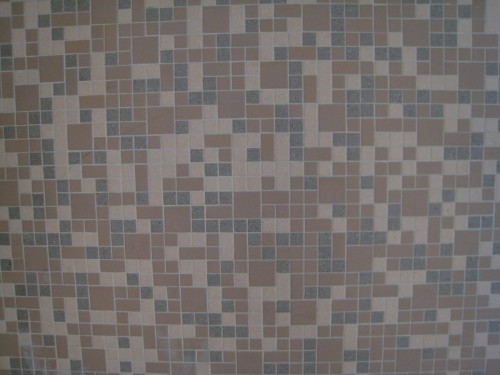There are many interior details at the Boettcher Center which contribute to its uniqueness and one of the ones I find the most interesting is its decorative wall tile.
On the walls leading into the upper auditorium and on walls throughout both of the existing lower restrooms you will find large expanses of 1″x1″ ceramic tile with 4″ square accents (see below). The larger pieces are terracotta in a field of an even mixture of terracotta, grey/white and blue. The overall pattern is variably random, with some splotches of mostly white/grey or mostly terracotta, with the larger pieces spaced fairly evenly (though not prescriptively) apart.
At first the randomness seems a little out of place within the rigid International Style of the Center, but upon closer inspection I think it feels right at home. On the Auditorium exterior the monochromatic elements are highlighted with slight changes in material type with only the sometimes functional/sometimes decorative steel grating above the entrances providing contrast. This focus on formal and material changes rather than color is the key to understanding the place of a random tile pattern inside. If you think of the tile as a MATERIAL, rather than a pattern of individual pieces, then a random layout is the only option the architects had. Looking at the rest of the surfaces inside the original space, most instances of building unit patterning have been obscured. The ceiling and lower classroom walls are plastered over to create monolithic and joint-less expanses. The repetition of the cmu walls are sheathed in a plywood veneer, and even the wood horizontal joints of that layer are covered in battens which are laid out in a seemingly random pattern which breaks down the 4×8 sheets. So a strict tile pattern that repeats every 18 inches similar to the aluminum diamonds on the aforementioned grating outside might seem inappropriate compared to the uneven grain of the graceful pointilist close-up that the original designers provided.
So we decide to embrace the random pattern…but with new bathrooms that are to be tiled on the walls and floor, a new question comes up…how do you duplicate randomness?
We hope the answer is in percentages. In the diagram below we described what percent of each tile type would be represented by which color within a certain repeatable area, without establishing a pattern. This is a little trickier for your tile setter, but is not really that uncommon, especially in floor tiles. We’re counting on the result being in harmony with the existing building, and its eccentricities.










